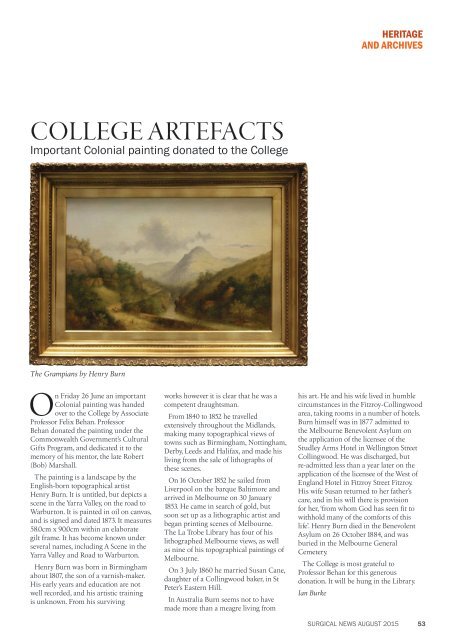SURGICAL NEWS
b6dhb_f
b6dhb_f
- No tags were found...
You also want an ePaper? Increase the reach of your titles
YUMPU automatically turns print PDFs into web optimized ePapers that Google loves.
HERITAGE<br />
AND ARCHIVES<br />
COLLEGE ARTEFACTS<br />
Important Colonial painting donated to the College<br />
The Grampians by Henry Burn<br />
On Friday 26 June an important<br />
Colonial painting was handed<br />
over to the College by Associate<br />
Professor Felix Behan. Professor<br />
Behan donated the painting under the<br />
Commonwealth Government’s Cultural<br />
Gifts Program, and dedicated it to the<br />
memory of his mentor, the late Robert<br />
(Bob) Marshall.<br />
The painting is a landscape by the<br />
English-born topographical artist<br />
Henry Burn. It is untitled, but depicts a<br />
scene in the Yarra Valley, on the road to<br />
Warburton. It is painted in oil on canvas,<br />
and is signed and dated 1873. It measures<br />
58.0cm x 90.0cm within an elaborate<br />
gilt frame. It has become known under<br />
several names, including A Scene in the<br />
Yarra Valley and Road to Warburton.<br />
Henry Burn was born in Birmingham<br />
about 1807, the son of a varnish-maker.<br />
His early years and education are not<br />
well recorded, and his artistic training<br />
is unknown. From his surviving<br />
works however it is clear that he was a<br />
competent draughtsman.<br />
From 1840 to 1852 he travelled<br />
extensively throughout the Midlands,<br />
making many topographical views of<br />
towns such as Birmingham, Nottingham,<br />
Derby, Leeds and Halifax, and made his<br />
living from the sale of lithographs of<br />
these scenes.<br />
On 16 October 1852 he sailed from<br />
Liverpool on the barque Baltimore and<br />
arrived in Melbourne on 30 January<br />
1853. He came in search of gold, but<br />
soon set up as a lithographic artist and<br />
began printing scenes of Melbourne.<br />
The La Trobe Library has four of his<br />
lithographed Melbourne views, as well<br />
as nine of his topographical paintings of<br />
Melbourne.<br />
On 3 July 1860 he married Susan Cane,<br />
daughter of a Collingwood baker, in St<br />
Peter’s Eastern Hill.<br />
In Australia Burn seems not to have<br />
made more than a meagre living from<br />
his art. He and his wife lived in humble<br />
circumstances in the Fitzroy-Collingwood<br />
area, taking rooms in a number of hotels.<br />
Burn himself was in 1877 admitted to<br />
the Melbourne Benevolent Asylum on<br />
the application of the licensee of the<br />
Studley Arms Hotel in Wellington Street<br />
Collingwood. He was discharged, but<br />
re-admitted less than a year later on the<br />
application of the licensee of the West of<br />
England Hotel in Fitzroy Street Fitzroy.<br />
His wife Susan returned to her father’s<br />
care, and in his will there is provision<br />
for her, ‘from whom God has seen fit to<br />
withhold many of the comforts of this<br />
life’. Henry Burn died in the Benevolent<br />
Asylum on 26 October 1884, and was<br />
buried in the Melbourne General<br />
Cemetery.<br />
The College is most grateful to<br />
Professor Behan for this generous<br />
donation. It will be hung in the Library.<br />
Ian Burke<br />
<strong>SURGICAL</strong> <strong>NEWS</strong> AUGUST 2015 53


